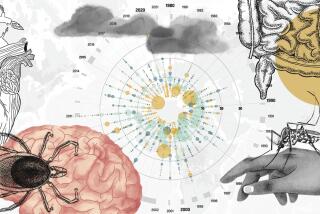World Facing Disease Crisis, Report Warns
- Share via
Declaring a “global crisis” and warning that “no country is safe from infectious diseases,” the World Health Organization reports today that scourges such as malaria and AIDS continue to run rampant, killing more than 17 million people worldwide last year, including 9 million children.
Taken together, bacterial, viral and parasitic diseases remain the world’s leading cause of premature death, accounting for one out of every three deaths, the report says.
The figures reflect a disheartening trend in which old enemies are resurfacing to thwart 20th century medicine’s proud ability to control infection. For instance, the No. 1 infectious disease, tuberculosis, took 3.1 million lives last year, up 400,000 from WHO figures for 1993.
The report also suggests with uncommon starkness that we indeed live in a truly global community, where long-separated populations mix with unprecedented ease and disease organisms have the potential to spread between countries at jet speed.
“Contrary to the expectations of 10 or 20 years ago, when it was thought that infectious diseases were on the decline, we have a real problem now,” said Dr. David Brandling-Bennett, deputy director of the Pan American Health Organization and a consultant on the report. “Unless we take concerted action, those problems are going to get worse.”
But WHO, a United Nations agency, also gives reasons for optimism. Globally, the average life expectancy of a person born in 1995 is three years greater than that of someone born 10 years ago. And the longevity gap between developed and undeveloped countries has narrowed to 13.3 years, down from 25 in 1955.
Slightly fewer babies came into the world dangerously underweight last year compared to a decade ago, while dozens of countries have significantly improved their infant mortality rate.
And some infectious diseases have been brought under control. Widespread use of tetanus vaccine prevented an estimated 700,000 deaths from the disease last year, the report says. Poliomyelitis is on the verge of being eradicated, and Guinea worm disease is “being eliminated from 11 West African countries.”
“The message should not be all doom and gloom by any means,” Brandling-Bennett said.
Still, the overarching tone of World Health Report 1996 is rather alarming, in keeping with recent studies on emerging and surging infectious diseases by the U.S. Centers for Disease Control and the National Academy of Sciences.
The WHO report is intended to alert public health authorities in U.N. member countries to the need to beef up disease surveillance around the world. It accuses policymakers and researchers of “fatal complacency” for being caught off guard.
“Today’s crisis is likely to get worse before it gets better,” WHO director-general Dr. Hiroshi Nakajima says in the introduction.
Dr. Martin Blaser, director of infectious disease research at Vanderbilt University, suggested that events may justify some alarm.
“Infectious agents have existed since the beginning of time,” he said. “But the world is getting more densely populated. Something that occurs anywhere in the world can potentially affect the majority of the human race. That didn’t used to be the case. And that spells trouble for humans.”
Acute respiratory infections, including influenza and pneumonia (but not tuberculosis) made up the largest category of lethal infection, killing 4.4 million in 1995.
Among the reasons that many infectious diseases have not been curtailed, the WHO report says, are widespread poverty, population growth, urban crowding, massive refugee movements, environmental degradation, antibiotic resistance and heavy international air travel.
In addition, 30 “new,” or emerging, infectious agents have been discovered in the last two decades, from the AIDS virus to the Ebola virus. The problems posed by these pathogens, the report says, are “probably the most frightening.”
The spread of AIDS to all parts of the globe in two decades underscores the danger of new pathogens. WHO estimates that 20 million people worldwide are infected with the AIDS virus, HIV. “By the year 2000, it is estimated that there will be some 26 million adults living with HIV worldwide.”
For all the terror of the Ebola epidemic in Zaire last year, in which 245 of 316 victims died, it exemplifies a “model for rapid response,” says the report. Within 24 hours of learning of the first cases, specialists from Zaire, WHO, the U.S. Centers for Disease Control and other agencies arrived at the scene, where they worked together to track and treat cases, helping to contain the spread.
Although the burden of infectious diseases falls heaviest on developing countries, Americans are also vulnerable, as shown by recent epidemics of the newly discovered hantavirus, the rodent-borne bacteria that cause an often fatal lung infection.
(BEGIN TEXT OF INFOBOX / INFOGRAPHIC)
The 10 Biggest Killers
Infectious diseases formerly under control continue to exact a heavy toll, and in some cases are on the rise, especially in underdeveloped countries, according to the World Health Organization. Here, the world’s 10 leading infectious-disease killers, in 1995:
Acute respiratory infections: 4.4 million
Diarrheal diseases: 3.1 million
Tuberculosis: 3.1 million
Malaria: 2.1 million
Hepatitis B: 1.1 million
HIV / AIDS: 1 million
Measles: 1 million
Neonatal tetanus: 500,000
Whopping cough: 355,000
Roundworm and hookworm: 165,000
Source: The World Health Organization
More to Read
Sign up for Essential California
The most important California stories and recommendations in your inbox every morning.
You may occasionally receive promotional content from the Los Angeles Times.










